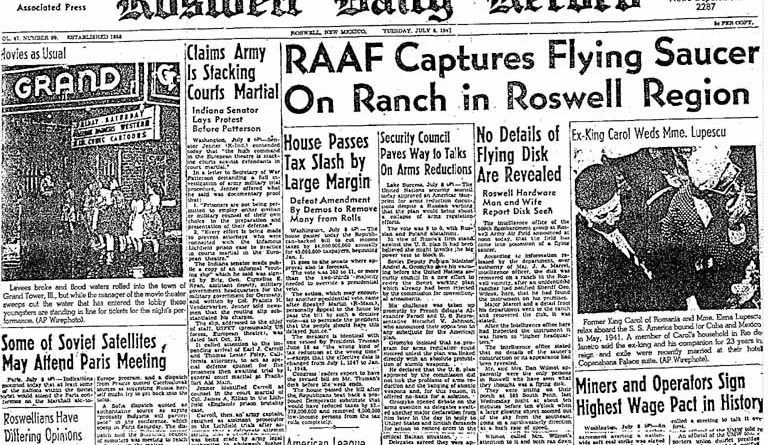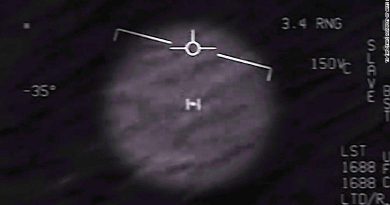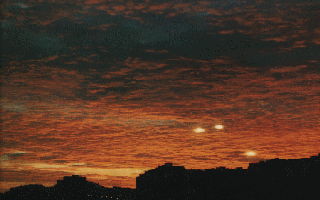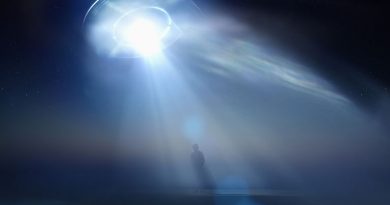The Roswell UFO Incident – Complete History
The Roswell UFO incident refers to the events surrounding the crash of a military Air Force surveillance balloon at a ranch near Roswell, New Mexico in the summer of 1947 which became the center of a number of claims alleging the crash was an extraterrestrial spaceship.
After an initial spike of interest in the crash, the military, wishing to conceal the true purpose of the balloon which was to detect Soviet nuclear testing, reported that the crash was merely a conventional weather balloon. Interest in the crash subsequently waned until the late 1970s when ufologists began promulgating a variety of increasingly elaborate conspiracy theories claiming that one or more alien spacecraft had crash-landed and that the extraterrestrial occupants had been recovered by the military who then engaged in a cover-up.
In the 1990s the US military published reports disclosing the true nature of the crashed Project Mogul balloon. Nevertheless, the Roswell incident continues to be of interest in popular media, and conspiracy theories surrounding the event persist. Roswell has been called “the world’s most famous, most exhaustively investigated, and most thoroughly debunked UFO claim”
The sequence of events was triggered by the crash of a Project Mogul balloon near Roswell. On July 8, 1947, the Roswell Army Air Field (RAAF) public information officer Walter Haut, issued a press release stating that personnel from the field’s 509th Operations Group had recovered a “flying disc”, which had crashed on a ranch near Roswell. The Military decided to conceal the true purpose of the crashed device nuclear test monitoring and instead inform the public that the crash was of a weather balloon. Later that day, the press reported that Commanding General of the Eighth Air Force Roger Ramey had stated that a weather balloon was recovered by the RAAF personnel. A press conference was held, featuring debris (foil, rubber and wood) said to be from the crashed object, which match the weather balloon description. Historian Robert Goldberg wrote that the intended effect was achieved: “the story died the next day”.
Subsequently the incident faded from the attention of UFO enthusiasts for more than 30 years.
On June 14, 1947, William Brazel, a foreman working on the Foster homestead, noticed clusters of debris approximately 30 miles (50 km) north of Roswell, New Mexico. This dateor “about three weeks” before July 8appeared in later stories featuring Brazel, but the initial press release from the Roswell Army Air Field (RAAF) said the find was “sometime last week,” suggesting Brazel found the debris in early July. Brazel told the Roswell Daily Record that he and his son saw a “large area of bright wreckage made up of rubber strips, tinfoil, a rather tough paper and sticks.” He paid little attention to it but returned on July 4 with his son, wife and daughter to gather up the material. Some accounts have described Brazel as having gathered some of the material earlier, rolling it together and stashing it under some brush. The next day, Brazel heard reports about “flying discs” and wondered if that was what he had picked up. On July 7, Brazel saw Sheriff Wilcox and “whispered kinda confidential like” that he may have found a flying disc. Another account quotes Wilcox as saying Brazel reported the object on July 6.
Wilcox called RAAF Major Jesse Marcel and a “man in plainclothes” accompanied Brazel back to the ranch where more pieces were picked up. “[We] spent a couple of hours Monday afternoon [July 7] looking for any more parts of the weather device”, said Marcel. “We found a few more patches of tinfoil and rubber.”
As described in the July 9, 1947 edition of the Roswell Daily Record,
The balloon which held it up, if that was how it worked, must have been 12 feet long, [Brazel] felt, measuring the distance by the size of the room in which he sat. The rubber was smoky gray in color and scattered over an area about 200 yards in diameter. When the debris was gathered up, the tinfoil, paper, tape, and sticks made a bundle about three feet long and 7 or 8 inches thick, while the rubber made a bundle about 18 or 20 inches long and about 8 inches thick. In all, he estimated, the entire lot would have weighed maybe five pounds. There was no sign of any metal in the area which might have been used for an engine, and no sign of any propellers of any kind, although at least one paper fin had been glued onto some of the tinfoil. There were no words to be found anywhere on the instrument, although there were letters on some of the parts. Considerable Scotch tape and some tape with flowers printed upon it had been used in the construction. No strings or wires were to be found but there were some eyelets in the paper to indicate that some sort of attachment may have been used.
A telex sent to an Federal Bureau of Investigation (FBI) office from the Fort Worth, Texas office quoted a Major from the Eighth Air Force (also based in Fort Worth at Carswell Air Force Base) on July 8, 1947 as saying that “The disc is hexagonal in shape and was suspended from a ballon by cable, which ballon was approximately twenty feet in diameter. Major Curtan further advices that the object found resembles a high altitude weather balloon with a radar reflector, but that telephonic conversation between their office and Wright field had not borne out this belief.” National Oceanic and Atmospheric Administration (NOAA) weather balloon after launching
Early on Tuesday, July 8, the RAAF issued a press release, which was immediately picked up by numerous news outlets:
The many rumors regarding the flying disc became a reality yesterday when the intelligence office of the 509th Bomb group of the Eighth Air Force, Roswell Army Air Field, was fortunate enough to gain possession of a disc through the cooperation of one of the local ranchers and the sheriff’s office of Chaves County. The flying object landed on a ranch near Roswell sometime last week. Not having phone facilities, the rancher stored the disc until such time as he was able to contact the sheriff’s office, who in turn notified Maj. Jesse A. Marcel of the 509th Bomb Group Intelligence Office. Action was immediately taken and the disc was picked up at the rancher’s home. It was inspected at the Roswell Army Air Field and subsequently loaned by Major Marcel to higher headquarters.
Colonel William H. Blanchard, commanding officer of the 509th, contacted General Roger M. Ramey of the Eighth Air Force in Fort Worth, Texas, and Ramey ordered the object be flown to Fort Worth Army Air Field. At the base, Warrant Officer Irving Newton confirmed Rameys preliminary opinion, identifying the object as being a weather balloon and its “kite,” a nickname for a radar reflector used to track the balloons from the ground. Another news release was issued, this time from the Fort Worth base, describing the object as being a “weather balloon”.
Competing accounts
The existence of so many differing accounts by 1994 led to a schism among ufologists about the events at Roswell. The Center for UFO Studies (CUFOS) and the Mutual UFO Network (MUFON), two leading UFO societies, disagreed in their views of the various scenarios presented by RandleSchmitt and FriedmanBerliner; several conferences were held to try to resolve the differences. One issue under discussion was where Barnett was when he saw the alien craft he was said to have encountered. A 1992 UFO conference had attempted to achieve a consensus among the various scenarios portrayed in Crash at Corona and UFO Crash at Roswell, however, the publication of The Truth About the UFO Crash at Roswell had “resolved” the Barnett problem by simply ignoring Barnett and citing a new location for the alien craft recovery, including a new group of archaeologists not connected to the ones the Barnett story cited.
Don Schmitt held that variations in narratives between different writers was not however an essential problem, commenting by way of comparison “We know Jesus Christ was crucified, we just don’t know where.”
Problems with witness accounts
Hundreds of people were interviewed by the various researchers, but critics point out that only a few of these people claimed to have seen debris or aliens. Most witnesses were repeating the claims of others, and their testimony would be considered hearsay in an American court of law and therefore inadmissible as evidence. Of the 90 people claimed to have been interviewed for The Roswell Incident, the testimony of only 25 appears in the book, and only seven of these people saw the debris. Of these, five handled the debris. Pflock, in Roswell: Inconvenient Facts and the Will to Believe (2001), makes a similar point about Randle and Schmitt’s UFO Crash at Roswell. Approximately 271 people are listed in the book who were “contacted and interviewed” for the book, and this number does not include those who chose to remain anonymous, meaning more than 300 witnesses were interviewed, a figure Pflock said the authors frequently cited. Of these 300-plus individuals, only 41 can be “considered genuine first- or second-hand witnesses to the events in and around Roswell or at the Fort Worth Army Air Field,” and only 23 can be “reasonably thought to have seen physical evidence, debris recovered from the Foster Ranch.” Of these, only seven have asserted anything suggestive of otherworldly origins for the debris.
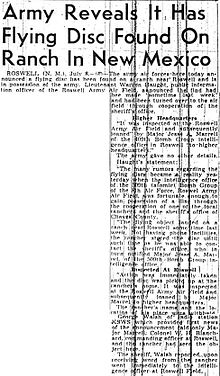
In The Roswell Incident, Marcel stated, “Actually, this material may have looked like tinfoil and balsa wood, but the resemblance ended there They took one picture of me on the floor holding up some of the less-interesting metallic debris The stuff in that one photo was pieces of the actual stuff we found. It was not a staged photo.” Timothy Printy points out that the material Marcel positively identified as being part of what he recovered is material that skeptics and UFO advocates agree is debris from a balloon device. After that fact was pointed out to him, Marcel changed his story to say that that material was not what he recovered. Skeptics like Robert Todd argued that Marcel had a history of embellishment and exaggeration, such as claiming to have been a pilot and having received five Air Medals for shooting down enemy planes, claims that were all found to be false, and skeptics feel that his evolving Roswell story was simply another instance of this tendency to fabricate
Evidence
Although there is no evidence that a UFO crashed at Roswell, believers firmly hold to the belief that one did, and that the truth has been concealed as a result of a government conspiracy. B. D. Gildenberg has called the Roswell incident “the world’s most famous, most exhaustively investigated, and most thoroughly debunked UFO claim”.
Pflock said, “The case for Roswell is a classic example of the triumph of quantity over quality. The advocates of the crashed-saucer tale simply shovel everything that seems to support their view into the box marked ‘Evidence’ and say, ‘See? Look at all this stuff. We must be right.’ Never mind the contradictions. Never mind the lack of independent supporting fact. Never mind the blatant absurdities.” Korff suggests there are clear incentives for some people to promote the idea of aliens at Roswell, and that many researchers were not doing competent work: ” UFO field is comprised of people who are willing to take advantage of the gullibility of others, especially the paying public. Let’s not pull any punches here: The Roswell UFO myth has been very good business for UFO groups, publishers, for Hollywood, the town of Roswell, the media, and UFOlogy [The] number of researchers who employ science and its disciplined methodology is appallingly small.”
B. D. Gildenberg wrote there were as many as 11 reported alien recovery site and these recoveries bore only a marginal resemblance to the event as initially reported in 1947, or as recounted later by the initial witnesses. Some of these new accounts could have been confused accounts of the several known recoveries of injured and dead servicemen from four military plane crashes that occurred in the area from 1948 to 1950. Other accounts could have been based on memories of recoveries of test dummies, as suggested by the Air Force in their reports. Charles Ziegler argued that the Roswell story has all the hallmarks of a traditional folk narrative. He identified six distinct narratives, and a process of transmission via storytellers with a core story that was created from various witness accounts, and was then shaped and molded by those who carry on the UFO community’s tradition. Other “witnesses” were then sought out to expand the core narrative, with those who give accounts not in line with the core beliefs being repudiated or simply omitted by the “gatekeepers.” Others then retold the narrative in its new form. This whole process would repeat over time.
Roswellian Syndrome
Prominent skeptics Joe Nickell and co-author James McGaha identified a myth-making process, which they called the “Roswellian Syndrome”. In this syndrome a myth is proposed to have five distinct stages of development: Incident, Debunking, Submergence, Mythologizing, and Reemergence and Media Bandwagon Effect. The authors predicted that the Roswellian Syndrome would “play out again and again”, in other UFO and conspiracy-theory stories.
Shoddy research revealed; witnesses suspected of hoaxes
The Air Force reports on the incident suggested that basic research that was claimed to have been carried out was not in fact carried out, a fact verified in a 1995 Omni magazine article. Glenn Dennis, who testified that Roswell alien autopsies were carried out at the Roswell base, and that he and others were the subjects of threats, was deemed one of the “least credible” Roswell witnesses by Randle in 1998. In Randle and Schmitts 1991 book UFO Crash at Roswell, Dennis’s story was featured prominently. Randle said Dennis was not credible “for changing the name of the nurse once we had proved she didn’t exist.” Dennis’s accounts were also doubted by researcher Pflock.
Some prominent UFOlogists including Karl T. Pflock, Kent Jeffrey William L. Moore, have become convinced that there were no aliens or alien space craft involved in the Roswell crash.
Alien autopsy hoax
In 1995, film footage purporting to show an alien autopsy and claimed to have been taken by a US military official shortly after the Roswell incident was released by Ray Santilli, a London-based video entrepreneur. The footage caused an international sensation when it aired on television networks around the world. In 2006, Santilli said that the film was mostly a reconstruction, but continued to claim it was based on genuine footage now lost, and some original frames that had supposedly survived. A fictionalized version of the creation of the footage and its release was retold in the comedy film Alien Autopsy (2006).
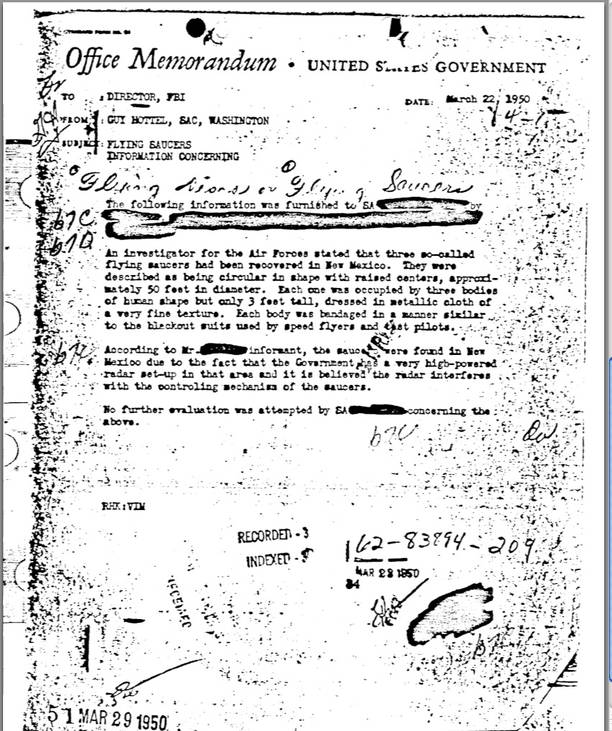
US political interest
On October 26, 2007, Bill Richardson (who at the time was a candidate for the Democratic Party nomination for U.S. President) was asked about releasing government files on Roswell. Richardson responded that when he was a Congressman, he attempted to get information on behalf of his New Mexico constituents, but was told by both the Department of Defense and Los Alamos Labs that the information was classified. “That ticked me off,” he said “The government doesn’t tell the truth as much as it should on a lot of issues.” He promised to work on opening the files if he were elected as President.
In October 2002, before airing its Roswell documentary, the Sci-Fi Channel hosted a Washington UFO news conference. John Podesta, President Clinton’s chief of staff, appeared as a member of the public relations firm hired by Sci-Fi to help get the government to open up documents on the subject. Podesta stated, “It is time for the government to declassify records that are more than 25 years old and to provide scientists with data that will assist in determining the true nature of the phenomena.”
Deathbed confessions
As time wore on, it became harder for Roswell researchers to find new evidence to publish; there was potential though in the prospect of deathbed confessions from those originally involved in 1947. In 2007 Donald Schmitt and Tom Carey published the book Witness to Roswell, which prominently featured a document said to be a sworn affidavit written by Walter Haut, who had written the first Army press release about the Roswell crash in 1947. The document, apparently kept under seal until Haut’s death in 2005, described how the 1947 crash debris had been discussed by high-ranking staff and how Haut had seen alien bodies. The claims, however, drew an unimpressed response even from ufologists: Dennis Balthaser said that the document was not written by Haut, and that by 2000 Haut’s mental state was such he could not recall basic details about his past, making the detail contained in the affidavit seem dubious. Physicist and skeptic Dave Thomas commented: “Is Roswell still the ‘best’ UFO incident? If it is, UFO proponents should be very, very worried.
See more at: http://www.educatinghumanity.com
